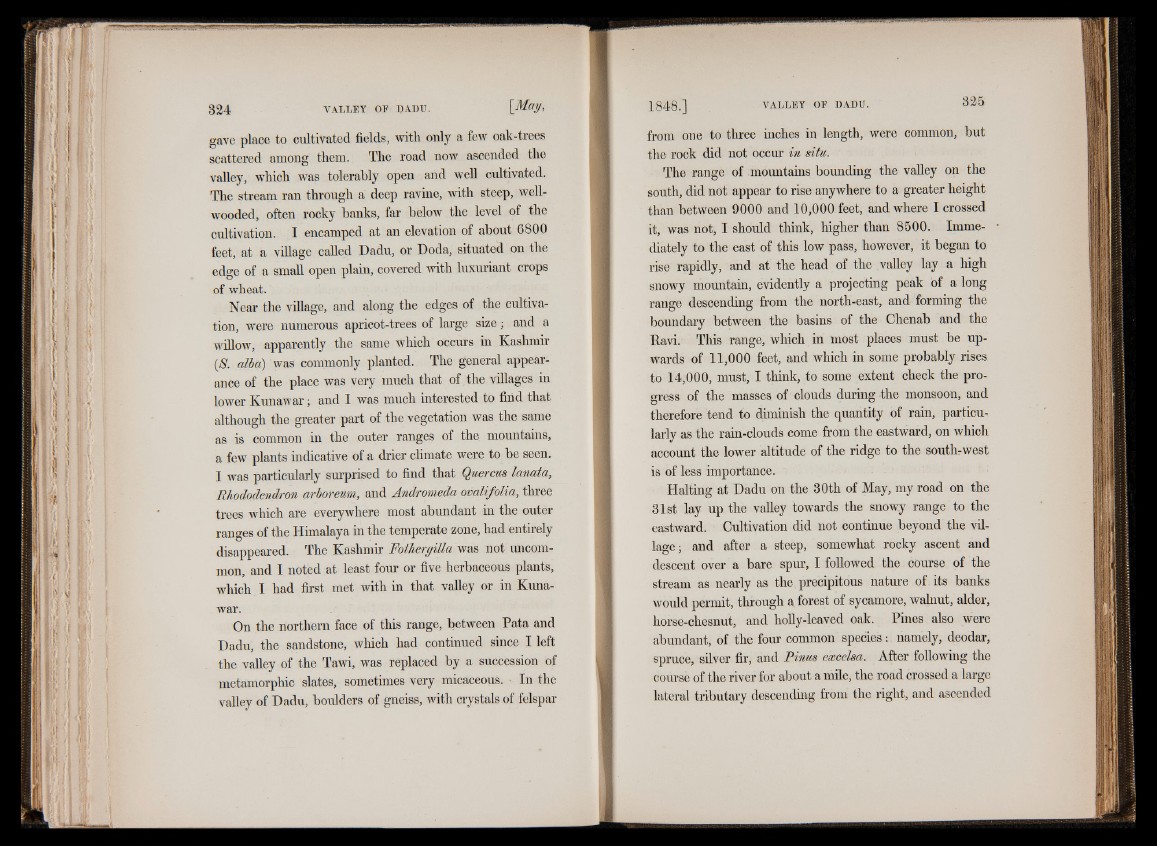
gave place to cultivated fields, with only a few oak-trees
scattered among them. The road now ascended the
valley, which was tolerably open and well cultivated.
The stream ran through a deep ravine, with steep, well-
wooded, often rocky banks, far below the level of the
cultivation. I encamped at an elevation of about 6800
feet, at a village called Dadu, or Doda, situated on the
edge of a small open plain, covered with luxuriant crops
of wheat.
Near the village, and along the edges of the cultivation,
were numerous apricot-trees of large size| and a
willow, apparently the same which occurs in Kashmir
(N. alha) was commonly planted. The general appearance
of the place was very much that of the villages in
lower Kunawar; and I was much interested to find that
although the greater part of the vegetation was the same
as is common in the outer ranges of the mountains,
a few plants indicative of a drier climate were to be seen.
I was particularly surprised to find that Quercus lanata,
Rhododendron arboreum, and Andromeda ovalifolia, three
trees which are everywhere most abundant in the outer
ranges of the Himalaya in the temperate zone, had entirely
disappeared. The Kashmir Fothergilla was not uncommon,
and I noted at least four or five herbaceous plants,
which I had first met with in that valley or in Kunawar.
On the northern face of this range, between Pata and
Dadu, the sandstone, which had continued since I left
the valley of the Tawi, was replaced by a succession of
metamorphic slates, sometimes very micaceous. > In the
valley of Dadu, boulders of gneiss, with crystals of felspar
from one to three inches in length, were common, but
the rock did not occur in situ.
The range of mountains bounding the valley on the
south, did not appear to rise anywhere to a greater height
than between 9000 and 10,000 feet, and where I crossed
it, was not, I should think, higher than 8500. Immediately
to the east of this low pass, however, it began to
rise rapidly, and at the head of the valley lay a high
snowy mountain, evidently a projecting peak of a long
range descending from the north-east, and forming the
boundary between the basins of the Chenab and the
Ravi. This range, which in most places must be upwards
of 11,000 feet, and which in some probably rises
to 14,000, must, I think, to some extent check the progress
of the masses of clouds during the monsoon, and
therefore tend to diminish the quantity of rain, particularly
as the rain-clouds come from the eastward, on which
account the lower altitude of the ridge to the southrwest
is of less importance.
Halting at Dadu on the 30th of May, my road on the
31st lay up the valley towards the snowy range to the
eastward. Cultivation did not continue beyond the village;
and after a steep, somewhat rocky ascent and
descent over a bare spur, I followed the course of the
stream as nearly as the precipitous nature of its banks
would permit, through a forest of sycamore, walnut, alder,
horse-chesnut, and holly-leaved oak. Pines also were
abundant, of the four common species pf namely, deodar,
spruce, silver fir, and Pinus excelsa. After following the
course of the river for about a mile, the road crossed a large
lateral tributary descending from the right, and ascended